The Dutch artist Lily van der Stokker creates monumental wall paintings which play on stereotypes of femininity and explore the mundane details of everyday life. Employing fluorescent, candy-coloured hues and decorative motifs such as flowers, fluffy clouds and curlicues, she questions conventional notions of artistic value and reclaims ‘feminine’ themes and aesthetics that have been historically disregarded. ‘We consider optimistic bright colors, curls and fun pink to be shallow and dumb. However, they seem to create a relaxing pleasure. It has been my life’s research to bring this beautiful strength into the forefront and to take away the negativity,’ she has said. Her current show ‘Thank You Darling’ at Camden Art Centre in London brings together works made between 1989 and 2021, exploring ideas relating to home, friendship, work, finances, illness and care.
Where is your studio?
I have a studio in Amsterdam and at our country house in the Netherlands, but I always make my wall paintings on location, so then the museum, gallery or outdoors becomes my temporary studio. I move over with all my tools, paint and assistants to these locations and make the space my own. I leave when the art is done and then I don’t see it anymore: a few months later it gets painted over.
My home studios are where I do the preparatory work, administration, and logistics. I am not a ‘make-artist’: I don’t paint my art myself, but I develop the concepts there and make the drawings which are the designs for the wall paintings. Sometimes people visit me and are disappointed to not see one of my paintings on the studio wall.
Which is your preferred space to work in?
Installing wall paintings is wonderful but physically tough – I can only do that a few times a year. My favourite home studio is in Amsterdam, but I must go up four floors of stairs to get to it which has become harder for me now because of my health. I have installed a chair elevator to try to solve that problem, but for the time being, I’m working mainly in the country house. It is a beautiful space with gardens in the front and back: a little paradise.
What makes it your favourite?
I started living and working there with my partner Jack in 1988. The house is filled with my art, paint, catalogues and archival memories, my and Jack’s art books, hundreds of framed drawings and left-over objects from wall-painting installations. After 34 years the house is completely stuffed full: we call it ‘the city castle’. It’s also a much bigger space than the studio in the country house: 185 square meters of old drafty rooms, right in the centre of Amsterdam. But I am also quite happy working in the country house studio. I have been slowly making a mini duplicate of the Amsterdam studio there.
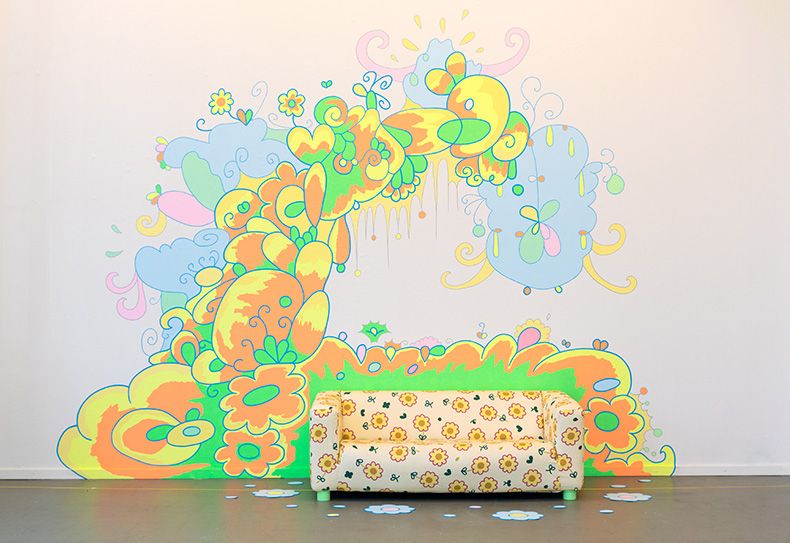
Installation view of Delicious Plus (2016), Lily van der Stokker at Art et Amicitiae, Amsterdam
Do you follow a particular working routine?
As I say, most of the work I do in the studio is paperwork and logistics: negotiations, emails, working out budgets. There’s little time spent on actual designing, but for me, the paperwork is also part of the creative process because it involves making creative decisions and caring for my art. But my drawing time is precious and fun. This is where I make my new steps. I have assistants who come in once or twice a week, and that’s when I start working on the drawing designs for the wall paintings. I make hundreds of them, so many never become wall paintings. I make the drawings and I choose the colours and the pencils and then my assistant fills it in – it is a bit like a colouring book.
Have you worked with the same assistants for many years?
Some of them have been with me for a very long time: Eva, Rolina, Maia and Ine. Others have joined me more recently: Agthe (from Belgium), Maria (from Madrid), Rosanna (from Brussels) and Amelia (from New York). My partner Yvo, now 78, also helps when we install. All of them are artists and are working on their own careers so sometimes they leave me to focus on that. The irregularity of their freelance artist life coincides nicely with mine. For the wall paintings, which we create on location, I work with a group of eight or nine young women, although Stefano a young man from Milan recently joined me.
What do you look for in an assistant?
The studio work seems easy but not everyone can do it: it’s precise work. I like a calm atmosphere, so I don’t like people to talk too much while we’re working. It’s interesting that it’s usually women who I work with, although for 25 years, I only had one assistant who helped with installing the wall paintings: Jan van Asbeck, who was a colleague and a friend. We went everywhere together making wall paintings, along with my partner Jack who died in 2013, but Jan wished to retire a few years ago. So now I’ve developed this group of women, which is nice: they seem to have become friends. When a large museum project is finished, such as the one at Camden Art Centre which took 23 days to complete, they jump into the air, and I take a photograph for Instagram. I call it ‘my assistant jump picture.’
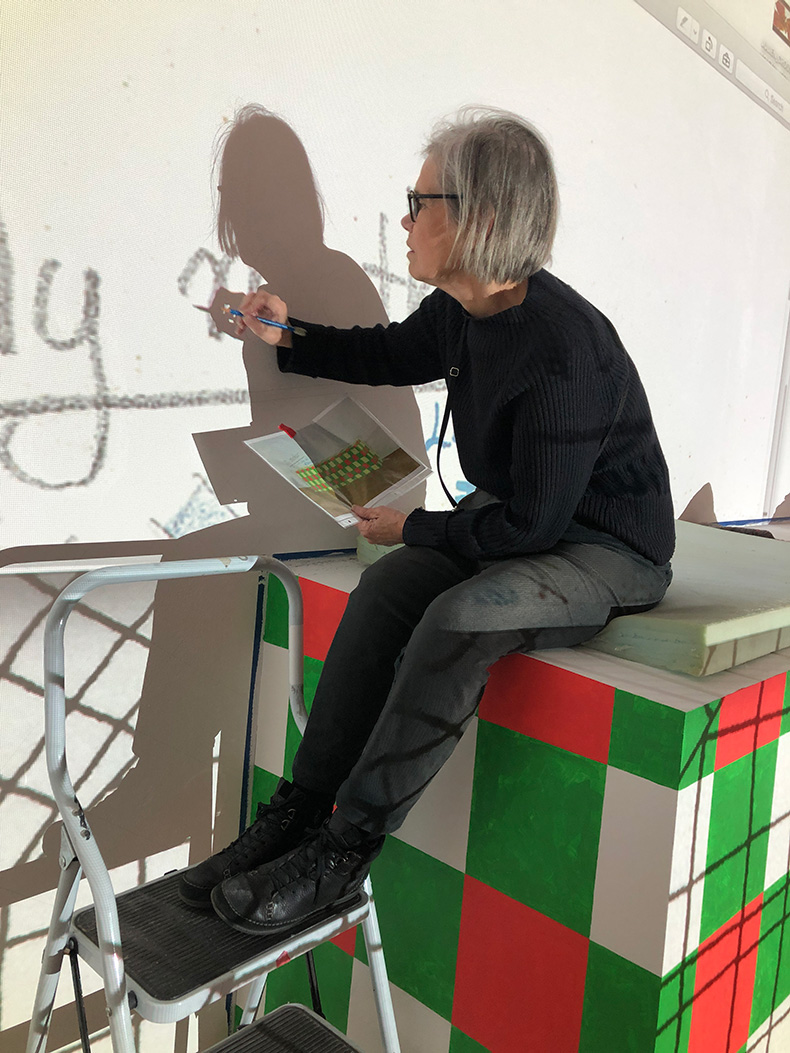
Lily van der Stokker working on The Loan at Camden Art Centre in London, 2022
Do you listen to anything while you’re working?
In my studio in Amsterdam in the 1990s I used to work on the marker drawings and listen endlessly to CDs and cassettes that Jack chose: cacophonies with no rhythm or melody. Now, I listen more to classical music because that’s what my partner Yvo plays on the piano in the room next to my studio every day: Beethoven, Satie, Chopin. Most recently, I’ve been playing CDs by my friend and the artist, philosopher and composer Jean-Philippe Antoine: it’s sort of quiet, calming noise.
What’s the strangest object in your studio?
We just came back from holiday in France where we went to flea markets and bought what we call ‘useless objects.’ It’s what we love doing when we are there. I have a closet full of useless objects: miniature pieces of furniture, floral vases from the 1970s. Some people think these objects are ugly, which relates quite closely to my work where the ugly and the beautiful are mixed in a complex way, the boundaries between them are blurred.
Do the objects ever make their way into your work?
I keep thinking about it, but I haven’t yet. Once years ago, when we were in Cornwall, we discovered that English people love teapots and that there are all these stores filled up with funny looking teapots, in the shape of houses and so on. My friend and I started collecting them and this eventually resulted in the seven-metre-high teapot sculpture titled Celestial Teapot that I put on the roof of a mall in Utrecht in 2013.
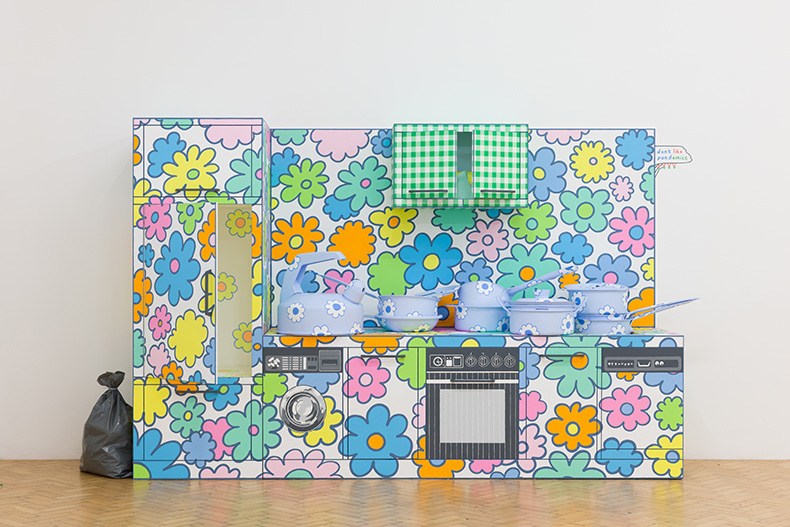
Installation view of ‘Lily van der Stokker: Thank You Darling’ at Camden Art Centre, London. Courtesy Camden Art Centre
Do you pin up works by other artists?
Oh yes, lots! In the country house, where I am now, we have lots of artworks by other artists, pieces we’ve picked up in flea markets, decorative ‘failed artworks’. Hanging in salon style in the hallway, we have a Tit Print by Brigid Polk from 1967 which she made in Andy Warhol’s factory, a piece from a larger installation by New York artist Nancy Shaver and abstract photography by my late partner Jack. There’s also a figurative sculpture of me lounging with my legs up in the air in my pyjama pants, which was made by my partner Yvo.
Is anything or anyone banned from the studio?
Food and drinks are banned from the tables where I make my drawings, but no people are banned, I don’t think.
‘Lily van der Stokker: Thank You Darling’ is at Camden Art Centre until 18 September.
Unlimited access from just $16 every 3 months
Subscribe to get unlimited and exclusive access to the top art stories, interviews and exhibition reviews.


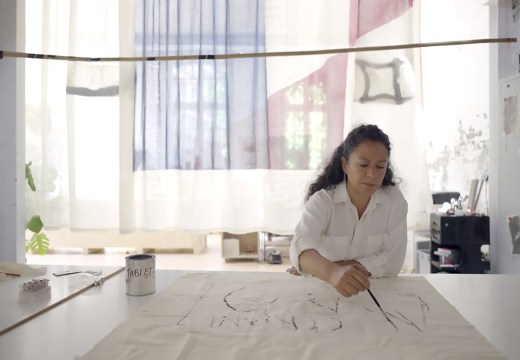

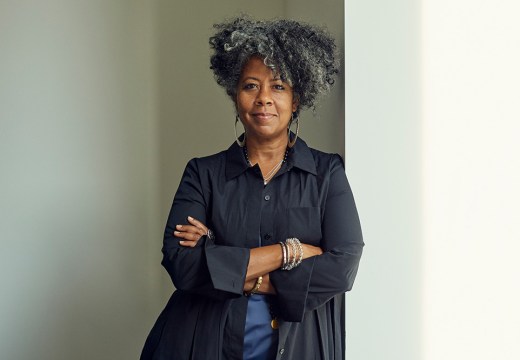









![Masterpiece [Re]discovery 2022. Photo: Ben Fisher Photography, courtesy of Masterpiece London](http://www.apollo-magazine.com/wp-content/uploads/2022/07/MPL2022_4263.jpg)
It’s time for the government of London to return to its rightful home